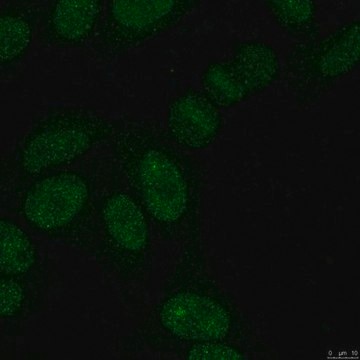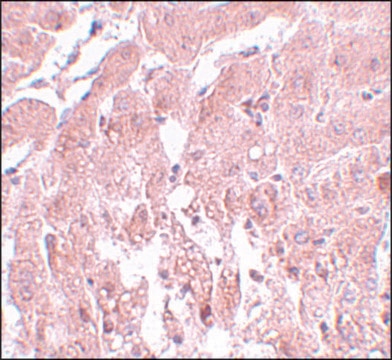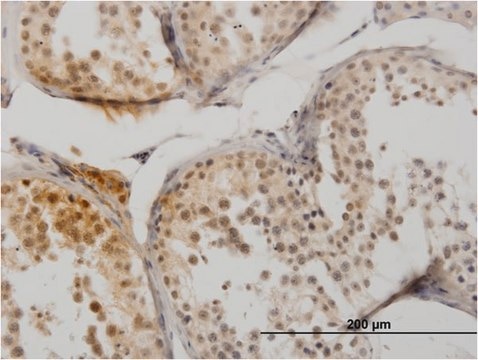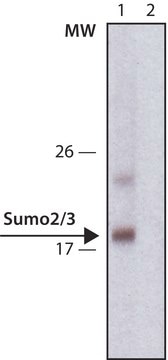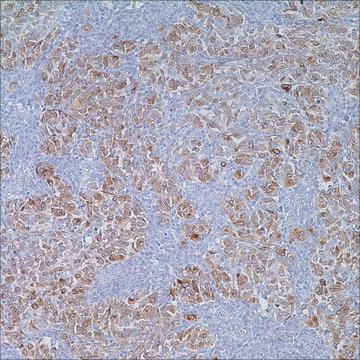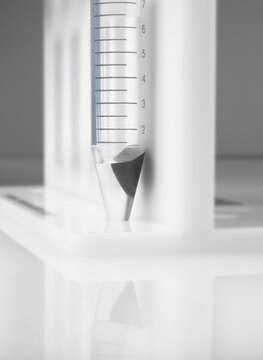MABS1139
Anti-SUMO2/3 Antibody, clone 3H12
clone 3H12, from rat
Synonym(s):
Small ubiquitin-related modifier 2, HSMT3, Sentrin-2, SMT3 homolog 2, Smt3B, SUMO-2, Ubiquitin-like protein SMT3B, Small ubiquitin-related modifier 3, SMT3 homolog 1, Smt3A, SUMO-3, Ubiquitin-like protein SMT3A
About This Item
Recommended Products
biological source
rat
Quality Level
antibody form
unpurified
antibody product type
primary antibodies
clone
3H12, monoclonal
species reactivity
mouse, human, rat
technique(s)
immunocytochemistry: suitable
western blot: suitable
isotype
IgG2aκ
shipped in
dry ice
target post-translational modification
unmodified
Gene Information
human ... SUMO2(6613)
General description
Specificity
Immunogen
Application
Immunocytochemistry Analysis: 10 µg/mL of purified clone 3H12 detected SUMO2/3 immunoreactivity in primary mouse neural progenitor cells (Courtesy of Taro Tachibana, Ph.D., Osaka City University, Japan).
Western Blotting Analysis: 1 µg/mL of purified clone 3H12 detected SUMOylated proteins in HeLa cell lysate (Courtesy of Taro Tachibana, Ph.D., Osaka City University, Japan).
Immunocytochemistry Analysis: A representative lot detected SUMO-2/3 nuclear immunoreactive foci co-localized with those of MCAF1 and SUMO1 and enriched in heterochromatin proteins by indirect immunofluorescent staining of exponentially growing C-33A cells fixed with 4% paraformaldehyde and permeabilized by 0.2% Triton X-100. Trasfecting C-33A cells with SUMO2/3 shRNA or Discosoma sp. red fluorescent protein (DsRed) fusion containg SUMO2/3-interacting sequence (MCAF1 a.a. 965-975) abolished nuclear staining by clone 3H12 (Uchimura, Y., et al. (2006). J. Biol. Chem. 281(32):23180-23190).
Signaling
Quality
Western Blotting Analysis: A 1:500 dilution of this hybridoma culture supernatant detected SUMO2/3-modified (SUMOylated) proteins in 10 µg of HeLa cell lysate.
Target description
Physical form
Storage and Stability
Handling Recommendations: Upon receipt and prior to removing the cap, centrifuge the vial and gently mix the solution. Aliquot into microcentrifuge tubes and store at -20°C. Avoid repeated freeze/thaw cycles, which may damage IgG and affect product performance.
Other Notes
Disclaimer
Not finding the right product?
Try our Product Selector Tool.
wgk_germany
WGK 2
Certificates of Analysis (COA)
Search for Certificates of Analysis (COA) by entering the products Lot/Batch Number. Lot and Batch Numbers can be found on a product’s label following the words ‘Lot’ or ‘Batch’.
Already Own This Product?
Find documentation for the products that you have recently purchased in the Document Library.
Our team of scientists has experience in all areas of research including Life Science, Material Science, Chemical Synthesis, Chromatography, Analytical and many others.
Contact Technical Service